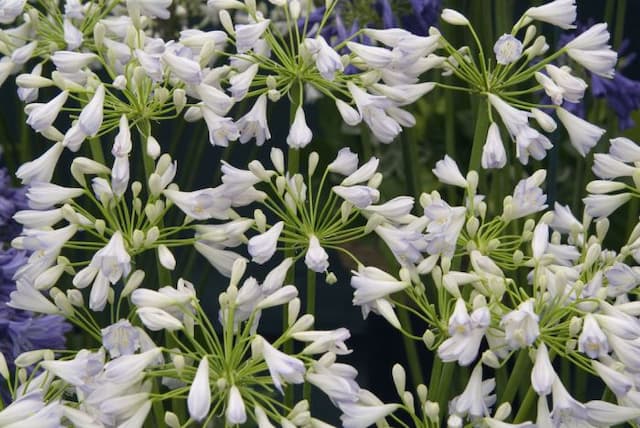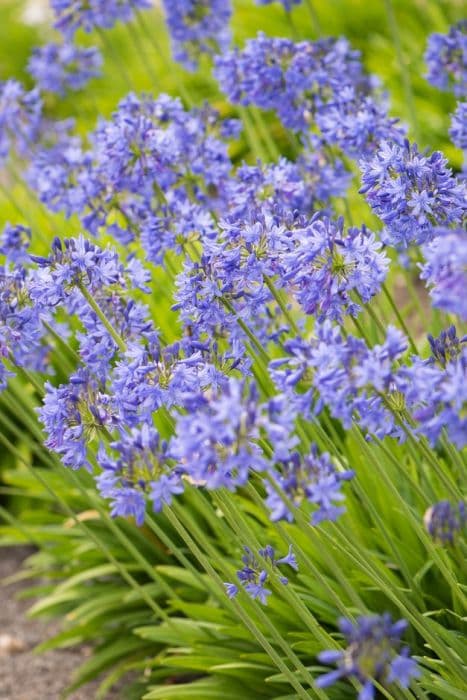Lily of the Nile Agapanthus 'Silver Anniversary'
![African lily [Silver Anniversary]](/_next/image?url=https%3A%2F%2Fplants-admin.emdemapps.com%2Fimages%2Fplants%2F%2Fimages%2F604b57b4dde96.png&w=3840&q=75)
ABOUT
Agapanthus 'Silver Anniversary' is an ornamental plant known for its striking foliage and blooms. It boasts variegated leaves that have a base color of rich green with contrasting edges or margins that are creamy-white or silver, creating an eye-catching pattern. During the blooming period, which usually takes place in summer, the plant produces beautiful globular clusters of flowers atop sturdy, upright stems. These flowers are typically a deep blue or purple color, and they are arranged in a spherical, almost fireworks-like display. The overall impression is one of lushness and vibrant color, making the Agapanthus 'Silver Anniversary' a popular choice for gardeners looking to add both texture and showy floral displays to their gardens. The variegation of the leaves adds interest even when the plant is not in bloom, ensuring that it remains an attractive feature throughout the growing season.
About this plant
 Names
NamesFamily
Amaryllidaceae
Synonyms
African Lily, Lily of the Nile, Love Flower
Common names
Agapanthus 'Silver Anniversary'.
 Toxicity
ToxicityTo humans
Agapanthus is known to contain compounds that can be toxic when ingested. While not typically considered highly toxic to humans, consumption of its parts can lead to symptoms such as nausea, vomiting, abdominal pain, and diarrhea. It’s important to handle the plant with care to prevent skin irritation as well. Ingesting significant quantities of Agapanthus could potentially lead to more severe health consequences, so it's best to avoid eating any part of this plant.
To pets
Agapanthus can be toxic to pets, including dogs and cats. If a pet ingests part of an Agapanthus plant, they may exhibit signs of toxicity such as vomiting, diarrhea, salivation, lethargy, or abdominal pain. In severe cases, ingestion could lead to more serious issues such as tremors or cardiac problems. It is important to keep Agapanthus out of reach of pets and to seek veterinary care if you suspect your pet has eaten any portion of the plant.
 Characteristics
CharacteristicsLife cycle
Perennials
Foliage type
Evergreen
Color of leaves
Green
Flower color
White
Height
2 feet (60 centimeters)
Spread
2 feet (60 centimeters)
Plant type
Bulb
Hardiness zones
8
Native area
South Africa
Benefits
 General Benefits
General Benefits- Attractive Flowers: The Agapanthus 'Silver Anniversary', commonly known as Lily of the Nile, produces globular clusters of trumpet-shaped white flowers that are aesthetically pleasing and can enhance the beauty of any garden.
- Drought Resistance: Once established, Lily of the Nile is quite drought-tolerant, making it suitable for regions with low rainfall or for gardeners who prefer low-maintenance plants.
- Long Blooming Period: This plant has a long blooming period during the summer months, providing a prolonged display of flowers.
- Attracts Wildlife: The blossoms of Lily of the Nile can attract pollinators such as bees and butterflies, promoting biodiversity.
- Architectural Foliage: Its strappy, evergreen leaves provide an architectural element to gardens year-round, even when the plant is not in bloom.
- Container Gardening: Lily of the Nile is suitable for container gardening, allowing it to be incorporated into patios, balconies, and other small spaces.
- Low Maintenance: The plant generally requires minimal upkeep beyond the occasional watering and removal of spent flower stalks, making it ideal for busy gardeners.
- Frost Tolerance: It exhibits some degree of frost resistance, allowing it to survive in cooler climates given some protection or mulching during the coldest months.
- Versatility in Landscape Design: This Agapanthus variety can be used in a variety of garden designs, from borders to mass plantings or as a focal point in the landscape.
 Medical Properties
Medical PropertiesThis plant is not used for medical purposes.
 Air-purifying Qualities
Air-purifying QualitiesThis plant is not specifically known for air purifying qualities.
 Other Uses
Other Uses- Photographic subject: Due to its striking appearance with variegated leaves and beautiful flowers, Agapanthus can be frequently used as a photogenic subject for botanical photography and garden portfolios.
- Floral art: The long stems and globe-shaped blooms of Agapanthus make them an ideal choice for contemporary floral art and installations, particularly in modern garden design themes.
- Educational model: Agapanthus can be grown in schools and educational institutions as a model plant to teach about plant biology, reproduction, and hybridization techniques.
- Dye production: The deep blue to violet flowers of some Agapanthus varieties can be used to produce natural dyes for fabrics and crafts, although 'Silver Anniversary' with its white blooms may yield lighter shades.
- Garden border definition: 'Silver Anniversary', with its variegated foliage and clumping habit, can serve as an attractive and natural way to define the edges and borders within a garden landscape.
- Ecological studies: Agapanthus plants can be subjects of ecological and environmental studies, observing how they interact with local wildlife, including pollinators and pest species.
- Companion planting: Agapanthus can be used in companion planting strategies to provide structure and color contrast with lower-growing plants or groundcovers.
- Pond and poolside ornamentation: The lush foliage and striking flowers of Agapanthus make it an excellent choice for decorating the surrounding areas of ponds and pools, creating a tropical or luxury feel.
- Wedding decorations: As Agapanthus can symbolize love and devotion, 'Silver Anniversary' can be used in wedding bouquets and venue decorations, celebrating a special milestone.
- Seasonal arrangements: Agapanthus can be a part of various seasonal floral arrangements, with 'Silver Anniversary' being particularly well-suited for summer displays due to its blooming season.
Interesting Facts
 Feng Shui
Feng ShuiThe African Lily is not used in Feng Shui practice.
 Zodiac Sign Compitability
Zodiac Sign CompitabilityThe African Lily is not used in astrology practice.
 Plant Symbolism
Plant Symbolism- Love Letters: The name Agapanthus derives from the Greek words 'agape,' meaning love, and 'anthos,' meaning flower. Thus, it is often associated with love and can symbolize a message of love or an epistle.
- Beauty: With its striking blue to purple flowers, the Agapanthus is commonly seen as a symbol of beauty and is sometimes used in bouquets and arrangements to highlight natural elegance.
- Enduring Love: The 'Silver Anniversary' variety, in particular, suggests a lasting relationship or marriage, as a silver anniversary celebrates 25 years of commitment.
- Prosperity: Because of its lush, full blooms and lengthy flowering season, the Agapanthus can symbolize abundance and prosperity.
 Water
WaterThe Lily of the Nile should be watered deeply until the soil is moist but not waterlogged, generally requiring about 1 inch of water weekly. During the active growing season in spring and summer, maintain consistent moisture, but allow the topsoil to dry out slightly between waterings to prevent root rot. In fall and winter, reduce watering to every other week, providing less than half an inch of water as the plant’s growth slows. If grown in a container, ensure proper drainage to allow excess water to escape. Overhead watering is discouraged to prevent wetting the foliage and potentially causing fungal diseases.
 Light
LightLily of the Nile prefers full sun but can tolerate partial shade, especially in the hottest part of the day. The ideal spot would provide at least 6 hours of direct sunlight but offer some protection during the afternoon. They thrive in bright locations, so an outdoor spot that meets this sunlight requirement or a sunny window if grown indoors would be suitable.
 Temperature
TemperatureLily of the Nile generally does well in temperatures between 50°F and 80°F and can tolerate short periods of colder weather but should be protected from frost, with minimum survival temperatures around 28°F to 32°F. The ideal temperature for abundant flowering ranges from 60°F to 70°F. Plants should be moved indoors or provided with frost protection if outdoor temperatures are expected to drop below the minimum survival range.
 Pruning
PruningPruning Lily of the Nile involves removing spent flower stalks to encourage additional blooming and maintain a tidy appearance. The best time to prune is after flowering, usually in late summer or early fall. The plant can also be cut back to the ground in late winter or early spring to remove old foliage and make way for new growth. Regular deadheading throughout the blooming season can also promote a longer display of flowers.
 Cleaning
CleaningAs needed
 Soil
SoilLily of the Nile 'Silver Anniversary' thrives in a rich, well-draining soil mix composed of loam, perlite, and compost. This soil combination promotes healthy root growth while ensuring proper moisture retention. The ideal soil pH range for this plant is slightly acidic to neutral, between 6.0 and 7.0.
 Repotting
RepottingLily of the Nile 'Silver Anniversary' typically needs repotting every 2 to 3 years to refresh the soil and accommodate the growing root system. Repot in spring or early summer before the plant enters its active growth phase.
 Humidity & Misting
Humidity & MistingLily of the Nile 'Silver Anniversary' prefers moderate humidity levels but can tolerate a range of conditions. Aim for about 40-60% humidity if possible, though the plant is fairly adaptable to the average indoor environment.
 Suitable locations
Suitable locationsIndoor
Place in bright, indirect light and avoid overwatering.
Outdoor
Full sun to partial shade; protect from frost.
Hardiness zone
8-11 USDA.
 Life cycle
Life cycleThe Lily of the Nile 'Silver Anniversary' begins its life cycle when its seeds germinate in spring, requiring well-draining soil and ample warmth. Seedlings emerge, developing into a rosette of strap-shaped, variegated green and white foliage. As the plant matures, it forms clumps with thick, fleshy roots and multiple leaf fans. By the second or third year, flower stalks rise above the foliage in summer, bearing globular clusters of trumpet-shaped flowers usually in shades of blue or white. After blooming, seed pods may form, which eventually dry and release seeds for the next generation. In colder climates, the plant may die back in winter, retreating to the ground to re-emerge in spring, while in warmer regions, the foliage remains evergreen, and the plant continues to grow, forming larger clumps over the years.
 Propogation
PropogationPropogation time
Spring-Early Summer
Agapanthus 'Silver Anniversary', commonly known as Lily of the Nile, is often propagated through division, which is the most popular method for this ornamental plant. The ideal time for dividing Agapanthus is after the blooming season, generally in early fall or late summer. To propagate through division, carefully lift the clump of Agapanthus from the ground using a spade, and then gently separate the clumps into smaller sections, each with several shoots and a portion of root. These divisions should then be replanted at the same depth they were growing previously, spacing them about 18 inches (approximately 45 centimeters) apart to allow for growth. Ample watering after replanting helps to establish the new plants. This process rejuvenates mature plants, stimulates new growth, and provides a simple and effective way to increase the number of Agapanthus plants in the garden.









